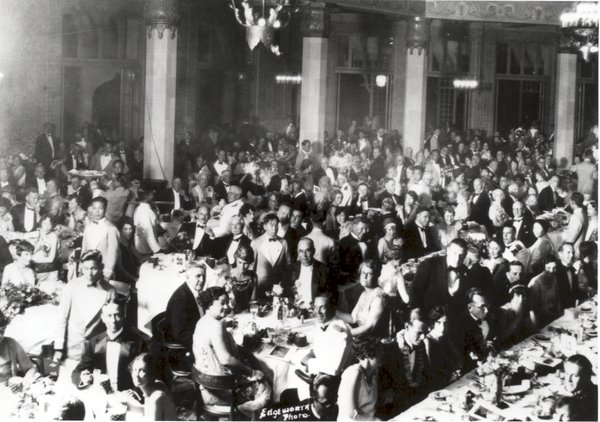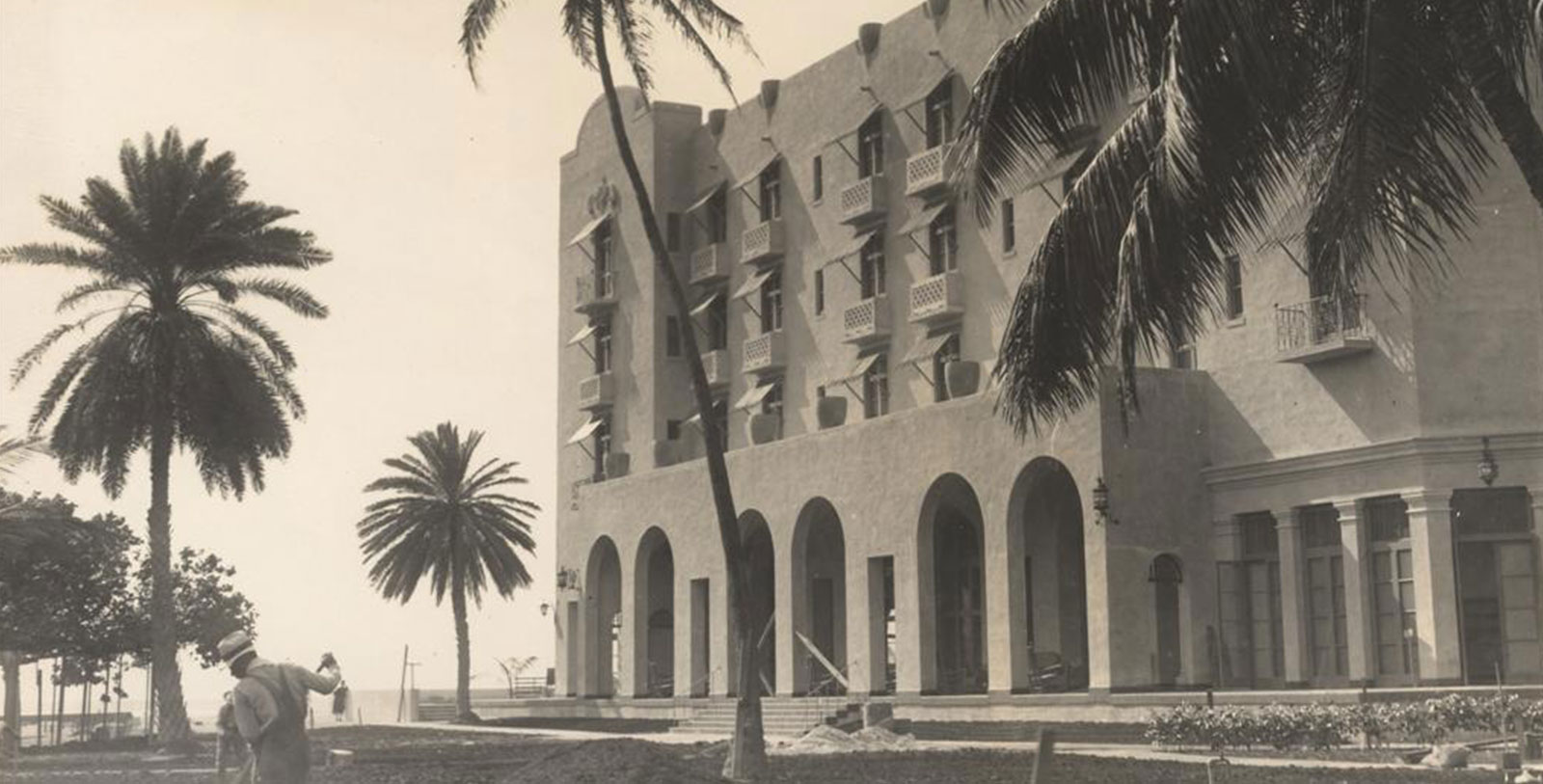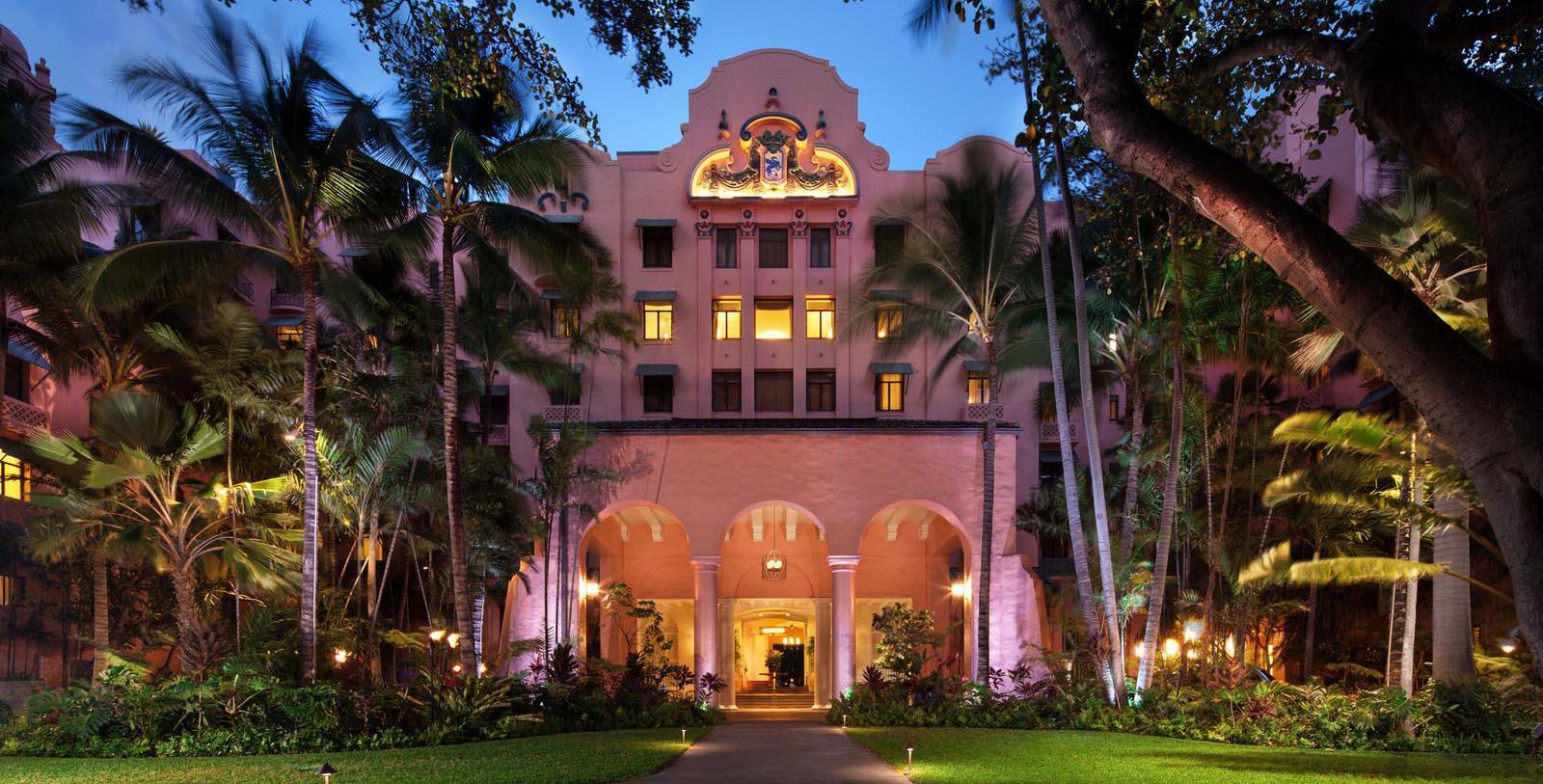Receive for Free - Discover & Explore eNewsletter monthly with advance notice of special offers, packages, and insider savings from 10% - 30% off Best Available Rates at selected hotels.
history
Discover The Royal Hawaiian, A Luxury Collection Resort, known as a destination of unparalleled luxury and romance and affectionately nicknamed "Pink Palace of the Pacific".
The Royal Hawaiian, A Luxury Collection Resort, a member of Historic Hotels of America since 2011, dates back to 1927.
VIEW TIMELINE
A Look at Hawaii's Two Most Iconic Hotels | Historic Hotels in Waikiki
The Royal Hawaiian and the Moana Surfrider (another member of Historic Hotels of America) grace Waikiki Beach, beckoning travelers from across the globe with their iconic stature, unmatched genuine Hawaiian hospitality and ode to yesteryear. Take a step back in time to learn about what makes these two resorts so special to Hawaii and the world.
WATCH NOWThe Royal Hawaiian, A Luxury Collection Resort, was constructed during the “Roaring Twenties,” in which flappers, the radio, and the Art Deco movement defined the age. As one of Honolulu’s earliest hotels, The Royal Hawaiian features a venerable history that harkens back decades. It first opened following a $4-million construction project that only took 18 months to complete. A group of investors led by the Matson Navigation Company hoped to erect a magnificent resort hotel along Waikiki Beach that would stand out among the rest. Their dream was realized thanks to the incredible talents of renowned architectural firm Warren and Wetmore. They used a spectacular blend of Spanish Revival and Moorish-inspired architecture for the building’s exterior, said by many to be inspired from the films of Rudolph Valentino. When the construction finally ceased, The Royall Hawaiian dominated the local skyline with its gorgeous pink façade.
The resort debuted on February 1, 1927, with a luxurious black-tie gala attended by more than 1,200 people. In seemingly no time at all, The Royal Hawaiian rapidly emerged as one of Honolulu’s most premier holiday destinations. Guests had affectionately taken to calling the beautiful hotel the “Pink Palace of the Pacific.” Many renowned celebrities began vacationing at The Royal Hawaiian, like Marilyn Monroe, Clark Gable, and Frank Sinatra. But its involvement with Hollywood went beyond merely providing a relaxing haven for its historic A-list celebrities—it also served as the set for several prominent films. Movies such as Big Jim McLain and Gidget Goes Hawaiian featured The Royal Hawaiian prominently within their stories. Various renowned statesmen—including General Douglas MacArthur—also stopped by the resort for long stretches of time. The Royal Hawaiian has even had the privilege of hosting two historic American presidents: Franklin Delano Roosevelt and Lyndon B. Johnson.
A member of Historic Hotels of America since 2011, the inspiring and distinctive character of The Royal Hawaiian, a Luxury Collection Resort, is known throughout the world as a place of unparalleled romance and luxury. The “Pink Palace of the Pacific' emerged as an internationally renowned resort following its complete renovation in 2009. Its distinctive rosy hue remains as it did during the 1920s, along with the rich architectural details originally installed by the hotels’ first owners. Now its 21st-century upgrades seamlessly meld with the thoughtfully chosen classic design elements, creating a decidedly chic atmosphere that is still captivatingly Hawaiian.
-
About the Location +
A member of Historic Hotels of America, The Royal Hawaiian is located in Waikiki Beach, which is one of Honolulu’s most celebrated neighborhoods. Known for its warm sand and turquoise waters, Waikiki Beach has long been a popular holiday destination for travelers around the world. Hawaiian noblemen first used the area as a vacation retreat as ancient chieftains settled the area centuries ago for tis tranquil atmosphere. The great King Kamehameha I even established his royal residence on the spot where The Royal Hawaiian stands today, when he established the Kingdom of the Hawaiian Islands toward the end of the 1700s. Foreigners then gradually began arriving to Waikiki over the next 100 years, slowly transforming the location into a preeminent tourist hotspot. By the time Hawaii became an American territory in the 1890s, Waikiki Beach and the rest of Honolulu were hosting hundreds of Americans ever year.
Recreational travel to Honolulu at the turn of the century was confined exclusively to luxury-class steamers that only the wealthiest could afford. These commercial passenger ships were operated by the Matson Navigation Company, which ran its cruise lines out of Los Angeles and San Francisco. Trips out to Hawaii were known to be arduous, as they lasted for close to a week. But passengers encountered a tropical paradise once they disembarked from their cramped quarters. Dozens of lodgings soon emerged throughout Honolulu to accommodate these travelers, with the first—the Moana Hotel—opening in 1901. Waikiki Beach was predominately a wetland at the time, inspiring local inhabitants to create the Ala Wai Canal. This trench drained the area, which rid it of mosquitoes and provided a solid foundation that aspiring hoteliers could build upon. Waikiki Beach became one of the main centers of development for these new hotels, with The Royal Hawaiian appearing along its Waikiki Bay in 1927.
One of the unique cultural activities that made Waikiki so attractive to American vacation-goers was the sport of surfing. Native Hawaiians viewed surfing as an art form in antiquity, where journeys out to sea sought to connect the human spirit with that of the ocean. Westerners observed surfing for the first time during the 1700s when they started exploring the Hawaiian archipelago but did not become truly exposed to it until the early 20th century. By this point in the region’s history, surfing had become a popular outdoor activity. Some locals even started to make something of a career out of it, traveling across Hawaii to teach others about the sport. Waikiki Beach soon became a gathering place for many surfers, who entertained countless tourists with their acrobatic skill. Among the most talented of these historic surfers was Duke Kahanamoku, a two-time Olympic Gold Medalist. Duke Kahanamoku practiced frequently at Waikiki Beach during the 1920s, and even visited The Royal Hawaiian on a regular basis.
-
About the Architecture +
The Royal Hawaiian—a member of Historic Hotels of America—debuted with a spectacular black-tie gala on February 1, 1927. This outstanding even heralded the start of a storied legacy of world-class hospitality that was to last for more than a century. Amazingly, The Royal Hawaiian only took around 18 months to complete. The original owners, Territorial Hotel Company, were the driving force behind its construction. Tearing down the Honolulu Seaside Hotel, the Territorial Hotel Company hired architectural firm, Warren and Wetmore, to design its replacement. Warren and Wetmore had crafted the appearance for many other renowned buildings throughout the country by that time, including the entire layout of Grand Central Terminal. They had even created the designs for several other historic hotels that are now a part of Historic Hotels of America, such as the Condado Vanderbilt Hotel, The Mayflower Hotel, and the Amway Grand Plaza Hotel (the Pantlind Hotel when it first opened).
Warren and Wetmore set about designing a beautiful H-shaped resort hotel along the shores of the famous Waikiki Beach. Standing six stories tall, the building originally had 400 beautiful accommodations that possessed their very own baths and balconies. The Royal Hawaiian did not come cheaply for The Territorial Hotel Company for it had spent some $4 million to construct the entire structure. The resort’s exterior was its most striking feature as the architects constructed it with pink stucco concrete. Inspired by Hollywood star Rudolph Valentino and his iconic Arabian-themed movies, the architects chose to erect the hotel’s stunning façade with a combination of Spanish Revival and Moorish-style architecture. This unique structural appearance managed to differentiate it completely from the rest of Honolulu’s skyline. The hotel’s stunning appearance even led guests to call it “The Pink Palace of the Pacific” within a matter of months after opening.
The Royal Hawaiian did not undergo another extensive construction project for the next eight decades, even after the hotel reopened following its use as a military facility in World War II. Starwood Hotels eventually acquired the location in 2008, which it subjected to an extensive restoration for the first time in its entire history. The project only took six months to complete, debuting as it originally did at the height of the “Roaring Twenties.” Starwood Hotels further continued its renovation in 2010 by refurbishing the fabulous Royal Beach Tower. When construction finally concluded, it featured state-of-the-art amenities and reinvigorated elegance. Additional construction work transpired on the structure five years later, which saw its rebranding as the luxurious “Mailani Tower” before awe-struck crowds.
-
Famous Historic Events +
Attack on Pearl Harbor (1941): Like the rest of Honolulu, The Royal Hawaiian was on the frontline when the Japanese Empire staged its surprise attack on the naval base at Pearl Harbor on December 7, 1941. The battle was an aerial assault consisting of three waves of Japanese planes that were launched from six aircraft carriers stationed several miles out at sea. The Japanese specifically intended for the attack to cripple the strength of the United States Navy in the Pacific by sinking all eight of its battleships moored nearby. All of the vessels were badly damaged, with four sunk. One battleship—the USS Arizona—was blown in half, taking more than two-thirds of its crew with her. Many other ships were damaged and over 3,000 Americans were wounded as a result of the three-hour-long strike.
The Attack on Pearl Harbor coincided with a simultaneous series of Japanese invasions across the Pacific, in which Japan began assailing American, British, and Dutch military bases throughout Southeast Asia. President Franklin Delano Roosevelt gave his famous “Infamy Speech” later that afternoon, in which he galvanized a shocked nation to preserve in the face of such reckless aggression. Japan later formally declared war against the United States on December 8, followed shortly thereafter by its allies, Germany and Italy.
Soon after the Pearl Harbor attack, the Navy Recreation and Morale Office leased the Royal Hawaiian, transforming the hotel into a major rest-and-relaxation center for Navy personnel—mostly for the submarine service. The interior was altered considerably, with the Coconut Grove cocktail bar becoming a soda fountain, and the beauty salon becoming a dispensary. Sailors on average would stay 10 days at the hotel with 3 people assigned per room, which was much better than a submarine.
The takeover period lasted over 3.5 years, and during that time all housekeeping was done by non-Japanese personnel. The famous Royal Hawaiian Band often put on concerts at the hotel during this time. After the war ended in September 1945, the Navy returned the hotel to Matson Navigation Co. on October 31st of that year, after which it took more than a year to return the hotel to the company's specifications. The old wine cellar in the basement, closed at the beginning of the war, went untouched under the Navy's ownership, with the door to the cellar having been cleverly sealed to make it look like part of the foundation.
-
Famous Historic Guests +
Mary Pickford, renowned actress known for her role in the silent film Coquette.
Douglas Fairbanks, famous actor known for his roles in Robin Hood¸ The Thief of Bagdad, and The Mark of Zorro.
Clark Gable, celebrated actor known for his roles in It Happened One Night, Mutiny on the Bounty, and Gone With the Wind.
Marlene Dietrich, renowned actress known for her roles in Morocco, Shanghai Express, and The Blue Angel.
Marilyn Monroe, famed actress known for her roles in Bus Stop and Some Like It Hot.
Elizabeth Taylor, celebrated actress known for her roles in Cleopatra and The Taming of the Shrew.
Natalie Wood, famous actress known for her roles in Rebel Without a Cause, Splendor in the Grass, and West Side Story.
Shirley Temple, renowned child actress known for her role in Bright Eyes and The Little Princess.
Frank Sinatra, celebrated actor and singer who sold over 150 million records worldwide.
Red Skelton, famous comedian known for his hit program, The Red Skelton Show.
George Burns, renowned comedian known for his role in The Sunshine Boys.
Joe DiMaggio, celebrated baseball player known as “The Yankee Clipper.”
Duke Kahanamoku, famous swimmer who popularized the sport of surfing.
Douglas MacArthur, American General remembered for his campaigns in the Philippines during World War II as well as the Korean Peninsula.
Princess Abigail Kawananakoa, prominent politician and heir to the former Kingdom of Hawaii.
Franklin Delano Roosevelt, 32nd President of the United States (1933 – 1945)
Lyndon B. Johnson, 36th President of the United States (1963 – 1969)
-
Film, TV and Media Connections +
The Royal Hawaiian has long been a canvas for unforgettable cinematic moments, blending Hollywood glitz with the tropical allure of Waikiki. During the Golden Age of Hollywood, the iconic destination perfectly embodied the fusion of cinematic glamour and nostalgic charm of faraway travel. Having served as a backdrop for numerous films and television shows over the past century, The Royal Hawaiian has been woven into the fabric of cinematic history, captivating audiences on the big and small screens with its timeless beauty and undeniable star power.
The numerous film and television projects The Royal Hawaiian has been featured in include:
NCIS: Hawaii (2021-2024)
Two Tickets to Paradise (2022)
Hawaii Five-0 (2010-2020)
Big Eyes (2014)
Mad Men: The Doorway (2013)
Punch-Drunk Love (2002)
My Wife and Kids: The Kyles Go to Hawaii (2002)
Eight Is Enough: Fathers and Other Strangers, Parts 1 and 2 (1979)
Goin' Coconuts (1978)
Charlie’s Angels: Angels in Paradise (1977)
Hawaii Five-O (1968-1980)
Gidget Goes Hawaiian (1961)
Big Jim McLain (1952)
Tom and Jerry: Cruise Cat (1952)
The Black Camel (1931)































